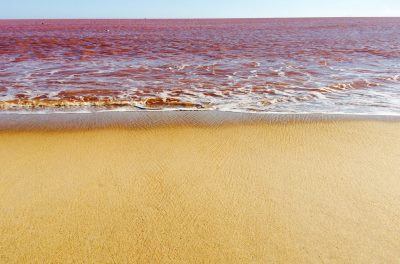IEA's São Carlos Center holds a debate on the consequences of the disaster in Mariana
 Four months after the disruption of the Fundão tailings dam belonging to the mining company Samarco, the disaster that spread iron ore waste troughout the course of the Doce River is still in progress. Thousands of people of the municipality of Mariana, where the catastrophe took place, and of other municipalities that depend on the affected river have had their lives changed because of the toxic mud: coastal communities have lost their main livelihood and the water collection in several municipalities has been impaired.
Four months after the disruption of the Fundão tailings dam belonging to the mining company Samarco, the disaster that spread iron ore waste troughout the course of the Doce River is still in progress. Thousands of people of the municipality of Mariana, where the catastrophe took place, and of other municipalities that depend on the affected river have had their lives changed because of the toxic mud: coastal communities have lost their main livelihood and the water collection in several municipalities has been impaired.
To discuss the effects of the tragedy, which extends not only to environmental issues, IEA's São Carlos Center will hold the debate The Doce River Valley: a Disaster in Progress on March 31, at 7.00 pm. The event will bring together four panelists and a moderator with different experiences on the subject. The event will be broadcast live on the web.
Marcelo Tramontano and Luciano Costa, both professors at the USP's Institute of Architecture and Urbanism (IAU), will discuss the experience of traveling through affected areas. Tramontano took about ten days to travel from Mariana, in the State of Minas Gerais, until Linhares, in the State of Espírito Santo, where the mouth of Doce River is located. He has also visited the ports where the ore is shipped abroad: Camburi, in Vitória (the capital of Espírito Santo), where trains arrive after leaving the Doce River Valley; and Ubu, in the municipality of Anchieta, end point of the pipeline that brings the ore directly from Mariana.
During his trip, Tramontano interviewed experts, activists, politicians, researchers, environmentalists, and the inhabitants of the region, such as indians, people in riverine settlements and traders. The footage will be used in order to produce a documentary. "The disaster brought the serious problems generated by mining activities to light, an issue that is not restricted to Mariana. All populations throughout the Doce River to the sea, including fauna and flora, are in jeorpardy," said Tramontano.
Costa gave priority to small cities and local roads, trying to be as close to the Doce River and its tributaries as he could. Working with Rafael Lazzarotto Simioni, a professor at the Faculty of Law of Southern Minas Gerais (MSDS) and at the University of the Sapucaí Valley (UNIVÁS), he has visited two districts that have been completely destroyed by the mud (Camargos and Paracatu de Baixo), and further municipalities on the way to Linhares.
"Through the photographs that have been taken, our perspective is to bring a set of impressions on the local culture, on the Doce River Valley and on the economic corporations operating in the region beyond the disaster. The 'mud', in my view, has allowed the restoration of a forgotten link between the economic corporations and the geographical space that the Valley is, often treated only as a resource," said Costa.
Professor Reinaldo Duque Brasil, from the Federal University of Juiz de Fora (UFJF), had a close experience with the problem. Besides being an expert in the Doce River Basin, he teaches at the UFJF campus of Governador Valadares, one of the cities that have suspended the water supply because of the contamination.
The group of debaters will be completed by Eduardo Mario Mendiondo, a professor at the USP's School of Engineering in São Carlos (EESC-USP), and general coordinator of the National Center for Monitoring and Natural Disaster Alerts of the Ministry of Science, Technology and Innovation (CEMADEN / MCTI). The moderator will be Marcel Fantin, a professor at the IAU and author of Agregados Minerais, Meio Ambiente e Urbanização na Perspectiva das Políticas Públicas Canadenses: Províncias de Ontário e Québec ("Mineral Aggregates, Environment and Urbanization in the Perspective of the Canadian Public Policy: Provinces of Ontario and Québec"), a book on Canadian public policy that addresses mineral aggregates and the insertion of the mining sector in the process of environmental, urban and regional planning.
The event is supported by the IAU and will be held in the Jorge Caron Auditorium on the USP's campus 1 in São Carlos.
